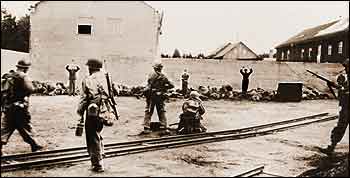| The bodies of surrendered Nazi troops lie crumpled at the base of a wall at Dachau moments after they were shot by US troops. (Army Signal Corps photo) |  |
|
 |
||
| By Thomas Farragher / Globe Staff / July 2, 2001 |
It was a chilling spring dawn a lifetime ago, the day before Hitler's suicide, a week before Americans danced in the streets to sweetly toast triumph in Europe.
But in that wan Sunday sunlight as the Allies raced for Munich and history, Felix Sparks, William Walsh, and John Lee were still combat soldiers trying to stay alive at the end of a long and bloody war. Still on fierce duty. Still hunting desperate Germans pushed to the brink of defeat and disgrace.
As the GIs were detoured into an intersection of righteousness and revenge at the Bavarian town of Dachau, they had no way of knowing they were marching toward one of the war's most egregious but barely explored cases of prisoner mistreatment by US forces in Europe.
They could not have fathomed that they would soon find themselves at the center of a US Army investigation into a massacre of German soldiers that General Dwight D. Eisenhower worried might erode America's moral authority to prosecute the Nazis at Nuremburg.
At first, they simply saw a train.
''The first goddamn thing we saw were 20 or 30 boxcars,'' said Walsh, a Newton native, his Boston accent chowder-thick. ''Some open at the top, some closed in. And here are all these goddamn people in it. And you kind of figure, well, maybe they're sleeping. Maybe they're hungry.
''You soon realize: They're all dead! What the hell is this? We had never seen anything like that before.''
Few had. The horrific lexicon is familiar now. Concentration camps. The Final Solution. Six million Jews murdered by a megalomaniac on a satanic mission. The Holocaust.
But the war-worn members of the 45th Infantry Division, who received radio orders to take Dachau on April 29, 1945, knew little or nothing of concentration camps. They knew only what they could see, hear, and smell.
The sight of 2,310 decomposing corpses on that train, an edgy silence interrupted by episodic gunfire, and the stench of death that hung in the air that day ignited a deadly fuse. It would quickly explode with fury and linger like gunsmoke for more than a half century.
The word went out at Dachau: We'll take no prisoners here. A machine gun was set up. Scores of captured acolytes of Hitler's Third Reich were herded into a dusty coal yard and lined up against a stucco wall.
Then American gunfire crackled. Germans fell. Officially, at least 17 were killed. Eleven other Germans who had surrendered were shot in two other locations at Dachau that day, according to records and interviews.


